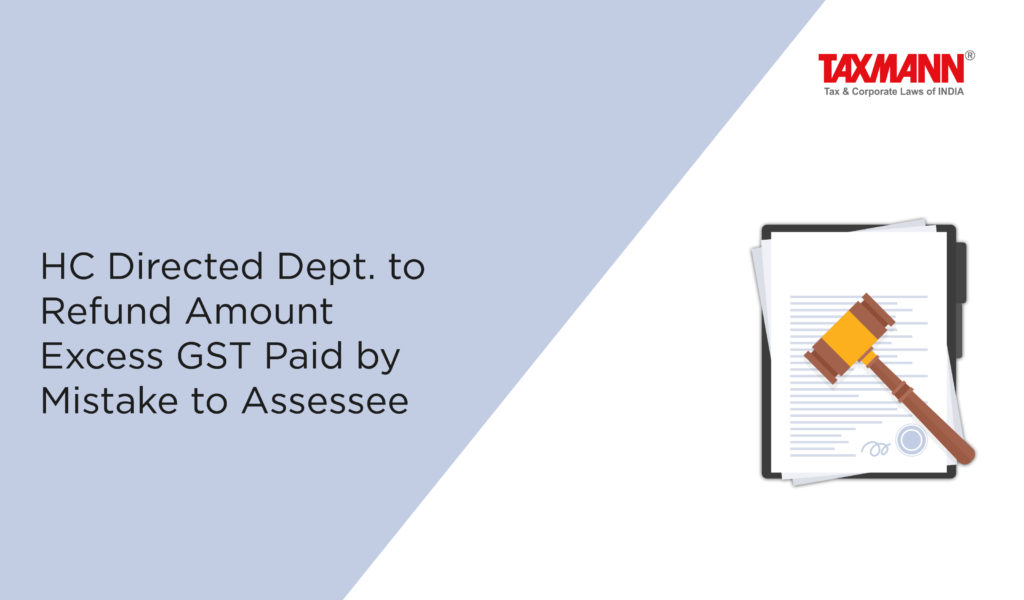HC Directed Dept. to Refund Amount Excess GST Paid by Mistake to Assessee
- News|Blog|GST & Customs|
- 2 Min Read
- By Taxmann
- |
- Last Updated on 26 July, 2023

Case Details: Tagros Chemicals India (P.) Ltd. v. Union of India - [2023] 152 taxmann.com 570 (Gujarat)
Judiciary and Counsel Details
-
- Vipul M. Pancholi & Devan M. Desai, Jj.
- Dhaval Shah for the Petitioner.
- Priyank P Lodha for the Respondent.
Facts of the Case
The assessee received purchase order from registered exporter to supply goods at concessional rate of IGST at rate of 0.1% in terms of Notification No. 41/2017-Integrated Tax (Rate), dated 23-10-2017. However, due to an error, the assessee supplied goods to buyer on payment of full duty of IGST at rate of 18% instead of concessional rate of 0.1 per cent.
Therefore, it filed refund claim in March, 2020 when mistake was found but the GST Authority rejected refund claim on basis of non-submission of documents by assessee which were required.
The assessee filed writ petition and contended that it had submitted invoice and a copy of letter written by recipient addressed to jurisdictional tax officer by intimating that they had raised purchase order and purchased goods.
High Court Held
The Honorable High Court noted that the assessee had raised relevant tax invoice and the buyer-exporter had exported goods under shipping bill. Also, the condition no.(ii) of Notification No. 41/2017-Integrated tax (Rate) that registered recipient should export goods within a period of 90 days from date of issue of a tax invoice by registered supplier had been fulfilled. However, the authority had rejected refund claim merely on basis of a technical ground but substantial benefit cannot be denied on the ground of technicalities or procedural lapses.
The Court further noted that if assessee paid duties by mistake on the goods which were exempted from payment would not mean that the goods would become goods liable for the duty. Therefore, it was held that the authority should refund amount along with interest.
List of Cases Reviewed
-
- Bonanzo Engineering & Chemical (P.) Ltd. v. Commissioner of Central Excise 2012 (277) E.L.T. 145 (SC) (para 16)
- Share Medical Care v. Union of India 2007 taxmann.com 1364/2007 (209) E.L.T. 321 (SC) (para 16) followed.
List of Cases Referred to
-
- Share Medical Care v. Union of India 2007 taxmann.com 1364/2007 (209) E.L.T. 321 (SC) (para 8)
- Bonanzo Engineering & Chemical (P.) Ltd. v. Commissioner of Central Excise 2012 (277) E.L.T. 145 (SC)(para 8)
Disclaimer: The content/information published on the website is only for general information of the user and shall not be construed as legal advice. While the Taxmann has exercised reasonable efforts to ensure the veracity of information/content published, Taxmann shall be under no liability in any manner whatsoever for incorrect information, if any.

Taxmann Publications has a dedicated in-house Research & Editorial Team. This team consists of a team of Chartered Accountants, Company Secretaries, and Lawyers. This team works under the guidance and supervision of editor-in-chief Mr Rakesh Bhargava.
The Research and Editorial Team is responsible for developing reliable and accurate content for the readers. The team follows the six-sigma approach to achieve the benchmark of zero error in its publications and research platforms. The team ensures that the following publication guidelines are thoroughly followed while developing the content:
- The statutory material is obtained only from the authorized and reliable sources
- All the latest developments in the judicial and legislative fields are covered
- Prepare the analytical write-ups on current, controversial, and important issues to help the readers to understand the concept and its implications
- Every content published by Taxmann is complete, accurate and lucid
- All evidence-based statements are supported with proper reference to Section, Circular No., Notification No. or citations
- The golden rules of grammar, style and consistency are thoroughly followed
- Font and size that’s easy to read and remain consistent across all imprint and digital publications are applied



 CA | CS | CMA
CA | CS | CMA
